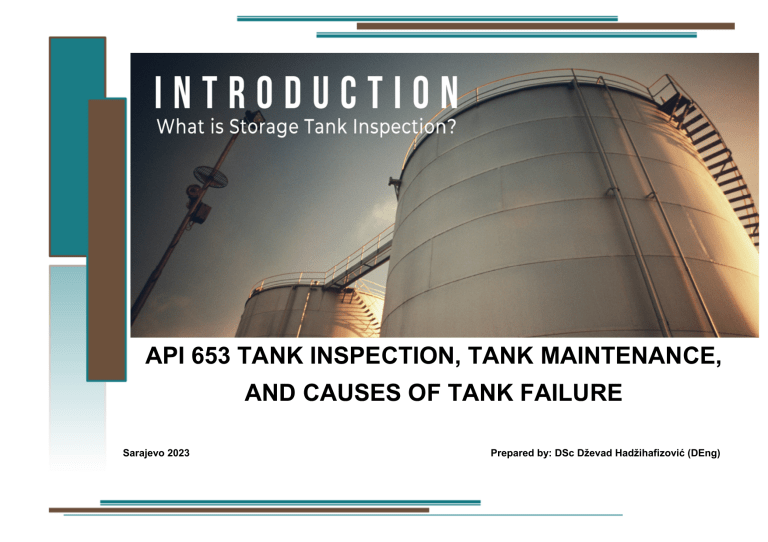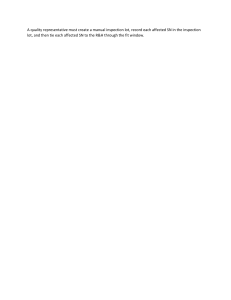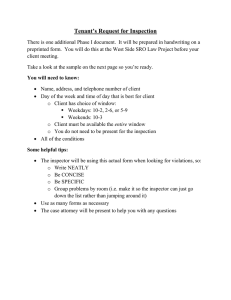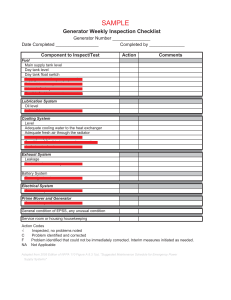
API 653 TANK INSPECTION, TANK MAINTENANCE, AND CAUSES OF TANK FAILURE Sarajevo 2023 Prepared by: DSc Dževad Hadžihafizović (DEng) API 653 Tank Inspections Why Inspect Your Tanks? • Prevent leaks into your secondary containment or to groundwater (if you do not have a secondary containment system) • Establish a baseline of tank condition and corrosion rates • Identify problems to perform repairs before you have a significant leak or release - Maintain your capital asset • Minimize chance of catastrophic tank failure PROPER INSPECTION PROTOCOL INSPECTOR CREDENTIALS • Certified API 653 Inspector Four years minimum experience with storage tanks Must pass test conducted by American Petroleum Institute (API) Inspectors receive an individual inspector number Inspector testing required every three years PROPER INSPECTION PROTOCOL • Visual inspection of welds, plates, and appurtenances • UT (Ultra-sonic Thickness) testing of shell courses, floor, and roof • Vacuum testing of all floor weld seams – unless epoxy coated • Identify bottom side corrosion on floors • Settlement Survey Checking for planar tilt Check for floor bulges or depressions • Provide calculations for safe or maximum fill height Weld deterioration Plate corrosion Interior piping corrosion Shell corrosion Weld deterioration and four-way junction – NON API Four-corner insert with reinforcing backup – NON API Evidence of interior shell corrosion Foundation evaluation Floor plate corrosion Lap-welded seam leak Floor coupon with bottom side corrosion Floor top side corrosion Severe roof corrosion Star light . . . Star bright! TANK MAINTENANCE – COMMON SENSE APPROACH • Conduct monthly/weekly walk-around of your tank(s) • Look for stains on steel where leak may be occurring • Check valve function and nozzle welds • Check associated piping • Check foundation for wash-out/deterioration • Keep good records of product in and out TANK MAINTENANCE – COMMON SENSE APPROACH • Open up your tank a minimum of every two years and conduct your own visual inspection inside • Check for weld deterioration and corrosion • If tank is coated, visually check coating for blisters or cracks • Keep a record of inspections and results • If tank has an internal containment liner, check leak monitor weekly • Conduct an API-653 inspection of your tank every five years as recommended by TFI (The Fertilizer Institute) WHAT IS THE API 650 SPECIFICATION API - AMERICAN PETROLEUM INSTITUTE Worldwide Standard for Above Ground Storage Tank Design and Construction • Provides requirements for calculations of shell plate thickness, man-way and nozzle design • Provides procedures for shell, roof and floor construction • Specifies material requirements and minimum thickness requirements • Specifies weld construction requirements, weld spacing, and x-ray requirements CAUSES OF CATASTROPHIC TANK FAILURE TANK FAILURES – COMMON CAUSES • Tank shell plates not thick enough for specific gravity of product stored • Over-filling of tank – over pressure • Cut-down and re-erected tanks using improper cutting and re-welding procedures • Improper weld procedures Lack of full weld penetrations (lack of weld fusion) Improper weld seam spacing Lack of radiograph (x-ray) of newly constructed tanks or on repaired tanks TANK FAILURES – COMMON CAUSES • Lack of weld fusion - #1 common cause • Welders not certified and tested to weld procedure • Weld deterioration/corrosion – especially in lower horizontal and vertical weld seams • Brittle fracture of steel • Lack of proper certified inspections • Tank erectors who know little about API Specifications and procedures – these companies attract customers with a “cheap” price. Make certain your contractor can verify that your tank meets API Specifications. DO YOUR OWN HOMEWORK Cut-down and re-welded tank Improper weld spacing Double wall 500,000 gallon tank, Illinois 2008 Cause – overfilling and lack of fusion on weld seams Yards of destruction Original tank foundation Weld seam rupture. Force of rupture “pushes back”. Rupture on side of camera location. Inspections Standard Operating Procedure 5 Aboveground Storage Tanks Aboveground Storage Tank Inspection This Standard Operating Procedure describes the steps that campus units that manage aboveground oil storage tanks (ASTs) or containers must follow to perform visual tank inspections. Checklists are attached. Monthly Tank Inspection (e.g., Aboveground Storage Tanks, Generator Tanks): Use and complete the Aboveground Storage Tank Monthly Inspection Checklist – Designate a knowledgeable individual to inspect tanks according to the attached checklist or an equivalent method pre-approved by the Division of Safety and Compliance. Monthly – Inspect aboveground tanks and associated valves, piping, and appurtenances. Visually assess the general condition of the tank or container and its appurtenances such as flange joints, expansion joints, valve glands and bodies, catch pans, pipeline supports, locking of valves, and metal surfaces. Also observe shells for signs of leaks or potential leaks, such as cracks, holes, rust, bulges, dents, residues, stains or other visual evidence. For oil/fuel containers that lack secondary containment and cannot be inspected or viewed on all sides for the presence of leaks, accurately inventory quantities at least monthly. Reconcile the amount of product used with the amount of product purchased to account for all inventory and confirm that product is not slowly leaking from the container. Keep written procedures and a record of inspections, inventories and tests, signed by the appropriate supervisor or designated inspector, with the SPCC Plan at your unit for at least 3 years. Certified inspector integrity tests records should be retained for the life of the tank. Report problems to the Unit Coordinator for corrective action. If you witness or discover a release of a petroleum product notify the appropriate personnel in accordance with SOP-1 Spill Reporting Procedures for University Personnel and Students. AST Inspection Checklist Guidance (Adopted from the Steel Tank Institute (STI) SP0001 inspection standard): For equipment not included in the STI SP0001 inspection standard, follow the manufacturer recommended inspection/testing schedules and procedures. The monthly AST Inspection is intended for monitoring the external AST condition and its containment structure. This visual inspection does not require a certified inspector. It shall be performed by an owner’s inspector who is familiar with the site and can identify changes and developing problems. Upon discovery of water in the primary tank, secondary containment area, interstice, or spill container, remove promptly or take other corrective action. Before discharge to the environment, inspect the liquid for regulated products or other contaminants and dispose of it properly. (*) designates an item in a non-conformance status. This indicates that action is required to address a problem. Non-conforming items important to tank or containment integrity require evaluation by an engineer experienced in AST design, a certified inspector, or a tank manufacturer who will determine the corrective action. Note the non-conformance and corresponding corrective action in the comment section. Retain the completed checklists for at least 3 years. In the event of severe weather (snow, ice, wind storms) or maintenance (such as painting) that could affect the operation of critical components (e.g., normal and emergency vents, valves), an inspection of these components is required immediately following the event. Last updated by: B. Liggett University of Illinois at Urbana-Champaign Page 1 of 12 http://www.fs.illinois.edu/services/safety-and-compliance Last Updated: Jan 2015 217-265-9828 Inspections Standard Operating Procedure 5 Monthly AST Inspection Checklist Monthly AST Inspection Checklist Unit: Inspection Date: Inspector Name: Container/System: (*) designates an item in a non-conformance status. This indicates that action is required to address a problem. Item 1.0 Tank Containment Water in primary tank, secondary containment, interstice, or spill container? Debris or fire hazard in containment? Drain valves operable and in a closed position? Containment egress pathways clear and gates/doors operable? Secondary containment or ground is damaged or stained? 2.0 Leak Detection Visible signs of leakage around the tank, concrete pad, containment, ringwall or ground? Valve seals or gaskets are leaking? Cracks in hosing present? Status Comments Yes* No Yes* No Yes No* Yes No* Yes* No Yes* No Yes* No Yes* No 3.0 Tank Attachments and Appurtances Ladder and platform structure secure with no sign of severe Yes corrosion or damage? Tank Liquid level gauge and alarms readable and in good Yes condition? All tank openings are properly Yes sealed? No* No* No* Vents are obstructed? Yes* No Pipelines or supports are damaged or deteriorated? Yes* No Buried pipelines exposed? Yes* No Last updated by: B. Liggett University of Illinois at Urbana-Champaign Page 2 of 12 http://www.fs.illinois.edu/services/safety-and-compliance Last Updated: Jan 2015 217-265-9828 Inspections Standard Operating Procedure 5 Monthly AST Inspection Checklist 4.0 Tank Structure Tank is dented, bulging, rusted, damaged, or deteriorated? Bolts, rivets, or seams are cracked or damaged? Tank supports are deteriorated or buckled? Tank foundations have eroded or settled? Double-walled tanks – Space between inner and outer walls is free of oil? 5.0 Other Conditions Oil/water separator is functioning properly? Are there other conditions that should be addressed for continued safe operation or that may affect the site SPCC plan? Security fencing, gates, locks, lighting are functional? Yes* No Yes* No Yes* No Yes* No Yes No* Yes No* Yes* No Yes No* Deficiencies and corrective actions must be documented on this inspection form. All leaks must be reported to the Division of Safety and Compliance at 217.265.9828. Remarks Signature (Inspector or Supervisor) Last updated by: B. Liggett University of Illinois at Urbana-Champaign Date: Page 3 of 12 http://www.fs.illinois.edu/services/safety-and-compliance Last Updated: Jan 2015 217-265-9828 Inspections Standard Operating Procedure 5 Annual AST Inspection Checklist Annual Aboveground Storage Tank Inspection: Use and complete the Aboveground Storage Tank Annual Inspection Checklist – Designate a knowledgeable individual to inspect tanks according to the attached checklist or an equivalent method pre-approved by the Division of Safety and Compliance. Annually: 1. Inspect the AST shell and associated piping, valves, and pumps including inspection of the coating for Paint Failure. 2. Inspect earthen containment structures including examination for holes, washout, and cracking in addition to liner degradation and tank settling. 3. Inspect concrete containment structures and tank foundations/supports including examination for holes, washout, settling, paint failure, in addition to examination for corrosion and leakage. 4. Inspect steel containment structures and tank foundations/supports including examination for washout, settling, cracking, and for paint failure, in addition to examination for corrosion and leakage. 5. Inspect cathodic protection system, if applicable, including the wire connections for galvanic systems and visual inspection of the operational components (power switch, meters, and alarms) of impressed current systems. 6. Remove promptly upon discovery standing water or liquid in the primary tank, secondary containment area, interstice, or spill container. Before discharge to the environment, inspect the liquid for regulated products or other contaminants and dispose of it properly. Keep written procedures and a record of inspections, inventories and tests, signed by the appropriate supervisor or designated inspector, with the SPCC Plan at your unit for at least 3 years. Records produced as a result of certified inspections should be retained for the life of the tank. Report problems to the Unit Coordinator for corrective action. If you witness or discover a release of a petroleum product notify the appropriate personnel in accordance with SOP-1 Spill Reporting Procedures for University Personnel and Students. AST Inspection Checklist Guidance (Adopted from STI SP0001 inspection standard): For equipment not included in the STI SP0001 inspection standard, follow the manufacturer recommended inspection/testing schedules and procedures. The annual AST Inspection is intended for monitoring the external AST condition and its containment structure. This visual inspection does not require a certified inspector. It shall be performed by an owner’s inspector who is familiar with the site and can identify changes and developing problems. Upon discovery of water in the primary tank, secondary containment area, interstice, or spill container, remove promptly or take other corrective action. Before discharge to the environment, inspect the liquid for regulated products or other contaminants and disposed of it properly. (*) designates an item in a non-conformance status. This indicates that action is required to address a problem. Non-conforming items important to tank or containment integrity require evaluation by an engineer experienced in AST design, a certified inspector, or a tank manufacturer who will determine the corrective action. Note the non-conformance and corresponding corrective action in the comment section. Retain the completed checklists for at least 3 years. In the event of severe weather (snow, ice, wind storms) or maintenance (such as painting) that could affect the operation of critical components (normal and emergency vents, valves), an inspection of these components is required immediately following the event. Last updated by: B. Liggett University of Illinois at Urbana-Champaign Page 4 of 12 http://www.fs.illinois.edu/services/safety-and-compliance Last Updated: Jan 2015 217-265-9828 Inspections Standard Operating Procedure 5 Annual AST Inspection Checklist Annual AST Inspection Checklist Unit: Inspection Date: Inspector Name: Container/System: (*) designates an item in a non-conformance status. This indicates that action is required to address a problem. Item Status 1.0 Tank Containment Containment structure in satisfactory condition? Drainage pipes/valves fit for continued service? 2.0 Tank Foundation and Supports Evidence of tank settlement or foundation washout? Cracking or spalling of concrete pad or ring wall? Tank supports in satisfactory condition? Water able to drain away from tank? Grounding strap secured and in good condition? 3.0 Cathodic Protection Comments Yes No* Yes N/A No* Yes* No Yes* No Yes No* Yes No* Yes No* CP system functional? Yes N/A No* Rectifier Reading: Yes No* Yes* No 4.0 Tank External Coating Evidence of paint failure? 5.0 Tank Shell/Heads Noticeable shell/head distortions, buckling, denting Yes* No or bulging? Evidence of shell/head Yes* No corrosion or cracking? 6.0 Tank Manways, Piping and Equipment within Secondary Containment Flanged connection bolts tight and fully engaged with Yes No* no sign of wear or corrosion? Last updated by: B. Liggett University of Illinois at Urbana-Champaign Page 5 of 12 http://www.fs.illinois.edu/services/safety-and-compliance Last Updated: Jan 2015 217-265-9828 Inspections Standard Operating Procedure 5 Annual AST Inspection Checklist Item Status Comments 7.0 Tank Roof Standing water on roof? Yes* No Evidence of coating cracking, crazing, peeling, blistering? Yes* No Holes in roof? Yes* No Yes No* Yes No* Insulation missing? Yes* No Are there noticeable areas of moisture on the insulation? Yes* No Mold on insulation? Yes* No Insulation exhibiting damage? Yes* No 8.0 Venting Vents free of obstructions? Emergency vent operable? Lift as required? 9.0 Insulated Roofs Is the insulation sufficiently protected from water Yes No* intrusion? 10.0 Level and Overfill Prevention Instrumentation of Shop-Fabricated Tanks Has the tank liquid level sensing device been tested to Yes No* ensure proper operation? Does the tank liquid level sensing device operate as Yes No* required? Are overfill prevention Yes No* devices in proper working N/A condition? 11.0 Electrical Equipment Are tank grounding lines in good condition? Is electrical wiring for control boxes/lights in good condition? Yes N/A No* Yes N/A No* Deficiencies and corrective actions must be documented on this inspection form. All leaks must be reported to the Division of Safety and Compliance at 217.265.9828. Last updated by: B. Liggett University of Illinois at Urbana-Champaign Page 6 of 12 http://www.fs.illinois.edu/services/safety-and-compliance Last Updated: Jan 2015 217-265-9828 Inspections Standard Operating Procedure 5 Annual AST Inspection Checklist Remarks Signature (Inspector or Supervisor) Last updated by: B. Liggett University of Illinois at Urbana-Champaign Date: Page 7 of 12 http://www.fs.illinois.edu/services/safety-and-compliance Last Updated: Jan 2015 217-265-9828 Inspections Standard Operating Procedure 5 Monthly Inspection Checklist - Portable Containers Short-Term Container Inspection (e.g., drums 55 gallons or more): “Short-term” containers are containers 55 gallons or greater that are used for storage of oil for less than 10 years. Short-term containers must be visually inspected at least monthly and the visual inspection must be documented. Use and complete the Short-Term Container Inspection Checklist – Designate an individual to conduct container inspections according to the attached checklist or an equivalent method pre-approved by the Division of Safety and Compliance. At least monthly – Inspect the top, bottom and sides of the container to observe for exterior dents, bulges, holes, missing bungs or caps, rust or other signs that might indicate leakage or potential leakage of contents. Ensure that the container is not in contact with the ground surface. If in contact with ground, note on checklist and immediately notify the Division of Safety and Compliance. Remove from service any “short-term” container that appears to pose risk of oil discharge and replace with an approved container if a substitute container. Remove from service all “short-term” containers prior to ten years of age. Document the inspection on the attached Short-Term Container Inspection Checklist (SOP-5b) and keep with the SPCC Plan at your unit for at least 3 years. Report problems to the unit coordinator for corrective action. Short-Term Container Inspection Guidance: The monthly Short-Term Container Inspection is intended for monitoring the external AST condition and its containment structure. This visual inspection does not require a certified inspector. Designated facility personnel who is familiar with the site and can identify changes and developing problems may perform the inspections. (*) designates an item in a non-conformance status. This indicates that action is required to address a problem. If 55-gallon drums are found to have non-conforming items that are important to containment integrity, the drum must be replaced. Retain the completed checklists for at least 3 years. Last updated by: B. Liggett University of Illinois at Urbana-Champaign Page 8 of 12 http://www.fs.illinois.edu/services/safety-and-compliance Last Updated: Jan 2015 217-265-9828 Inspections Standard Operating Procedure 5 Monthly Inspection Checklist - Portable Containers Monthly Inspection Checklist – Portable Containers University Unit: Storage Location (bldg/room): Container/System (drum, contents, etc): (*) designates an item in a non-conformance status. This indicates that action is required to address a problem. Item Inspection Date: 1.0 Tank Containment / Storage Area ASTs within designated Yes storage area? Debris, spills or other fire hazard in containment or Yes* storage area? Water in outdoor secondary Yes* containment? Drain valves operable and in a Yes closed position? Containment egress pathways clear and gates/doors Yes operable? Secondary containment or Yes* ground is damaged or stained? 2.0 Leak Detection Visible signs of leakage around the container, storage Yes* area or ground? 3.0 Container Noticeable container distortions, buckling, denting, bulging or leaking? Yes* Inspection Date: Inspection Date: No* Yes No* Yes No* No Yes* No Yes* No No Yes* No Yes* No No* Yes No* Yes No* No* Yes No* Yes No* No Yes* No Yes* No No Yes* No Yes* No No Yes* No Yes* No 4.0 Inspector Inspector Signature Deficiencies and corrective actions must be documented on this inspection form. All leaks must be reported to the Division of Safety and Compliance at 217.265.9828. Remarks Last updated by: B. Liggett University of Illinois at Urbana-Champaign Page 9 of 12 http://www.fs.illinois.edu/services/safety-and-compliance Last Updated: Jan 2015 217-265-9828 Inspections Standard Operating Procedure 5 Annual Inspection Checklist – Oil-filled Operational Equipment Transformer and other Oil-Filled Operational Equipment Inspection: “Oil-filled operational equipment” is equipment that includes an oil storage container which is present solely to support the function of the apparatus or the device. Oil-filled operational equipment is not considered a bulk storage container, and does not include oil-filled manufacturing equipment (flow-through process). Examples of oil-filled operational equipment include, but are not limited to: hydraulic systems lubricating systems gear boxes machining coolant systems heat transfer systems transformers circuit breakers electrical switches wind turbines Oil-filled operational equipment must be visually inspected at least annually and the visual inspection must be documented. Use and complete the Oil-filled Operational Equipment Inspection Checklist – Designate an individual to conduct container inspections according to the attached checklist or an equivalent method pre-approved by the Division of Safety and Compliance. At least annually – Inspect the equipment to observe for exterior dents, bulges, holes, missing bungs or caps, rust or other signs that might indicate leakage or potential leakage of contents. Remove from service or maintenance any oil-filled operational equipment that appears to pose risk of oil discharge. Keep written procedures and a record of inspections, inventories and tests, signed by the appropriate supervisor or designated inspector, with the SPCC Plan at your unit for at least 3 years. Report problems to the Unit Coordinator for corrective action. If you witness or discover a release of a petroleum product notify the appropriate personnel in accordance with SOP-1 Spill Reporting Procedures for University Personnel and Students. Last updated by: B. Liggett University of Illinois at Urbana-Champaign Page 10 of 12 http://www.fs.illinois.edu/services/safety-and-compliance Last Updated: Jan 2015 217-265-9828 Inspections Standard Operating Procedure 5 Annual Inspection Checklist – Oil-filled Operational Equipment Annual Inspection Checklist – Oil-Filled Equipment University Unit: Storage Location (bldg/room): Container/System (drum, contents, etc): (*) designates an item in a non-conformance status. This indicates that action is required to address a problem. Item 1.0 Containment / Storage Area ASTs within designated storage area? Debris, spills or other fire hazard in containment or storage area? Water in outdoor secondary containment? Drain valves operable and in a closed position? Containment egress pathways clear and gates/doors operable? Secondary containment or ground is damaged or stained? 2.0 Leak Detection Visible signs of leakage around the container, storage area or ground? Valve seals or gaskets are leaking? Visible signs of leakage around the tank, concrete pad, containment, ringwall or ground? Inspection Date: Inspection Date: Inspection Date: Yes No* Yes No* Yes No* Yes* No Yes* No Yes* No Yes* No Yes* No Yes* No Yes No* Yes No* Yes No* Yes No* Yes No* Yes No* Yes* No Yes* No Yes* No Yes* No Yes* No Yes* No Yes* No Yes* No Yes* No Yes* No Yes* No Yes* No Yes* No Yes* No Yes* No Noticeable container distortions, buckling, denting, bulging or leaking? Yes* No Yes* No Yes* No Equipment is dented, bulging, damaged, or deteriorated? Yes* No Yes* No Yes* No Cracks in hosing present? 3.0 Container/Equipment Last updated by: B. Liggett University of Illinois at Urbana-Champaign Page 11 of 12 http://www.fs.illinois.edu/services/safety-and-compliance Last Updated: Jan 2015 217-265-9828 Inspections Standard Operating Procedure 5 Annual Inspection Checklist – Oil-filled Operational Equipment 4.0 Other Conditions Are there other conditions that should be addressed for continued safe operation or that may affect the site SPCC plan? Ladder and platform structure secure with no sign of severe corrosion or damage? Security fencing, gates, locks, lighting are functional? Yes* No Yes* No Yes* No Yes No* Yes No* Yes No* Yes No* Yes No* Yes No* 5.0 Inspector Inspector Signature Deficiencies and corrective actions must be documented on this inspection form. All leaks must be reported to the Division of Safety and Compliance at 217.265.9828. Remarks Last updated by: B. Liggett University of Illinois at Urbana-Champaign Page 12 of 12 http://www.fs.illinois.edu/services/safety-and-compliance Last Updated: Jan 2015 217-265-9828




